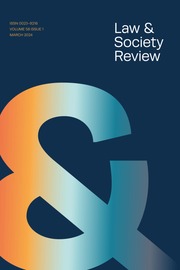Article contents
Measuring Precedent in a Judicial Hierarchy
Published online by Cambridge University Press: 01 January 2024
Abstract
Identifying the U.S. Supreme Court's most influential precedents is integral to understanding its impact on society. To make these identifications, scholars often analyze the network of citations in Supreme Court opinions. I contend that the broader jurisprudential significance of precedent can be better captured by considering how frequently a precedent is followed across the federal judicial hierarchy. In support of this contention, I present an analysis of original data on the treatment of every Court precedent 1946–2010 in all three levels of the federal judicial hierarchy. I show that a class of complex and ambiguous precedents are followed significantly less at all levels of the hierarchy. Yet these same fractious precedents exhibit high citation rates in Supreme Court opinions. The results show that different methodological choices capture strikingly different theoretical concepts, ones that are easily conflated in the study of legal precedent.
- Type
- Articles
- Information
- Copyright
- © 2016 Law and Society Association.
Footnotes
A previous version of this article was presented at the 2013 Political Networks Conference. I thank Lawrence Baum, Janet Box-Steffensmeier, Gregory Caldeira, Paul Debell, Jessica Defenderfer, Nicholas Felts, Shane Gleason, Jess Goode, Daniel Lempert, Yalidy Matos, Vittorio Merola, William Minozzi, Tom Nelson, Michael Neblo, Srinivas Parinandi, Katy Powers, Jack Wright, seminar participants at George Washington University, the editors, and the anonymous referees for valuable comments on this project. I thank Aubrey Patterson and Mary Lou Ranney for excellent research assistance. All remaining errors are my own.
References
- 14
- Cited by


